The Versailles Palace is a certified world heritage site for the past 30 years and it’s called one of the major achievements of 17th century French art. The palace is spread over 63,154 sq. and there are more than 2,300 rooms inside. The sheer number of rooms and the parts of the estate are bewildering in their size and scope.
Once you go to visit the place you will be offered a number of different tours each of which shows a particular selection of rooms aligned to a specific theme. The palace is the third most visited attraction in France after Louvre and Eiffel tower and is impossible to cover by foot fully in one day.
Back in 1789 Louis XVI was forced by the French revolution to flee the gorgeous palace of Versailles for Paris. The lovely palace never hosted royals again but it found a new job in 19th century when it was converted into Museum of French History by the royal order of King Louis Philippe. All the palace rooms hosted magnificent collections of sculptures and paintings which represented important historical works of art.
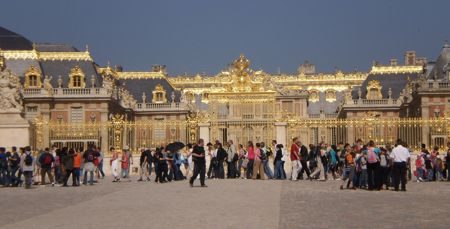
The art collections were expanded till the beginning of the 20th century under the supervision of the well-known curator Pierre de Nolhac. The historical role of the palace was re-established and the appearance of the Versailles Palace as a royal residence during the Ancien Regime was reaffirmed.
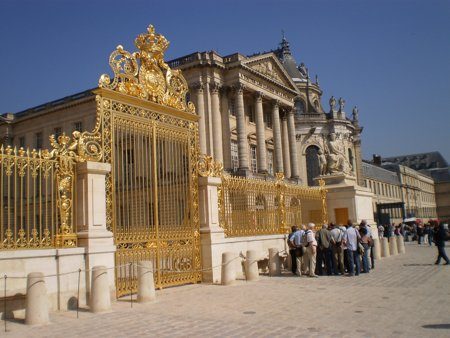
The Versailles Palace was never a medieval stronghold or a defence hub like many other palaces….it was termed a “chateau” or a luxurious residence in a rural location that was intended to showcase the king’s wealth and power. In fact the eastern end of the Versailles estate still has woods and agricultural estates…the French monarchy sourced their produce from these places. The palace is more of a showcase of opulence and imperial excesses, and a more intuitive look will tell you why the French revolution happened!!
There are hundreds of rooms in the palaces but the most important sections are described below…this is the crème de la crème of the estate’s attractions.
Hall of Mirrors
The Hall of Mirrors was built in place of a huge terrace that was flanked by the queens apartment (south) and kings apartment (north)….it took 6 years to build this dazzling gallery. The 73m hall is the highest representation of the economic clout and artistic brilliance of the French monarchy. The different political achievements are represented through paintings on the vaulted ceiling by the artist Le Brun.
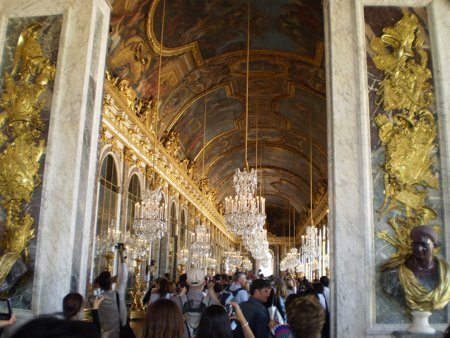
The illustrious history of Louis XIV remains the main subject though. One look at the 17 arches covered with more than 367 mirrors of huge proportions demonstrate that French can rival Venetians in mirror manufacturing. Check out the Rouge de Rance pilasters….they are coated with gilded bronze in a pioneer style invented by Le Brun. The hall of mirrors was used for celebrations….some of which demanded that the royal throne was placed at the end of a platform.
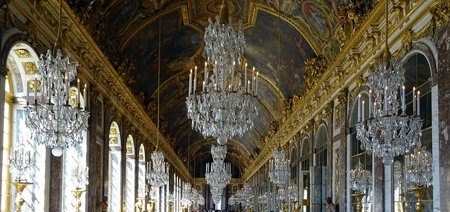
War Room
The war room started being built in the year 1678 and it’s a testament to the series of military victories which culminated in Nijmegen peace treaties. Hardouin Mansart created this glorious rooms whose walls are decorated with 6 trophies and weapons dipped in gilt. The wall right next to Apollo room has a very nice Coysevox created oval stucco which shows a horse mounted Louis XIV vanquishing his enemies.
Two large sculptures of pheme stand above the stucco and two captive statues lie under it. There is a false fireplace with a bas relief …look at a painting of Clio (history’s muse) recording the great deeds of the king here. Don’t miss the cupola ceiling which has a personified depiction of an armed France who is sitting on a cloud and is flanked by Victories. The lady has a shield decorated with the face of Louis XIV. All the ceiling arches have depictions of the enemies of the French… Germany kneels down with an eagle while Spain roars with a lion and Holland is thrown over another beast. Bellona; the fierce goddess is in a fury battle between Contention and Rebellion…in yet another arch. The war room is a capsule lesson of the medieval political- history of France.
Peace Room
The peace room is symmetrically aligned to war room and has similar marble panelled décor but the theme is of the rewards of peace. This much less ostentatious room is only separated from the queen’s apartment by a movable partition and was an integral part of the queen’s apartment. There used to be religious music lessons here every Sunday during the rules of Louis XV and Marie Antoinette.
Parade Apartments
The series of 7 apartments were called parade apartments as they were used for showing off the sovereign’s official events. This has Italian décor with the usual combination of painted ceiling and marble panels. The state apartments were open all day for the public to see the king and his family as they passed by to the royal chapel. During the rule of Louis XIV, evening gatherings were held here many times in a week.
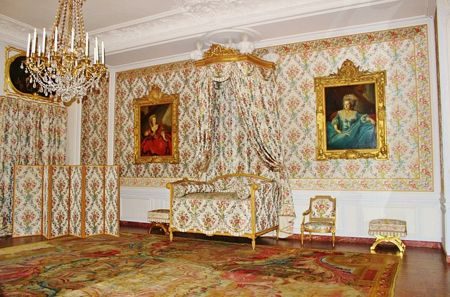
Hercules Room
The last room to be built by Louis XIV took 6 years to be completed and is dominated by the giant Veronese painting “Meal in the house of Simon” and the even bigger “Apotheosis of Hercules” (ceiling painting by Francois Lemoyne). The latter painting has more than 142 people and is labelled “Masterpiece” and a great example of Marouflage technique. Unfortunately Lemoyne committed suicide after he spent 4 excruciating years creating the room even after Louis XV made him the “First Painter”.
Royal Chapel
The Gothic looking Royal Chapel is a dedication to Saint Louis; patron saint of the king and the royal house’s ancestor. There is a vaulted ceiling with religious paintings and the apse and royal tribune are spectacularly lovely. The musical performances of the chapel were famous through Europe and the instrument here is of particular interest. Famous musicians like Couperin have performed here… don’t miss the King David depiction on the chapel instruments.
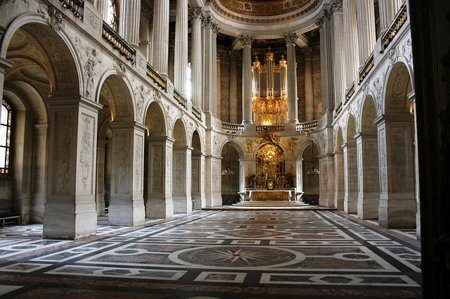
Other Rooms & Sections
Hall of Plenty
This was the refreshment room and the antechamber of Louis XIV ‘curiosity cabinet’/ ‘rarity room’. The French monarch displayed his collection of jewels, medallions, vases and gems with pride to his guests. The king’s vessel was depicted by a mastless ship artefact that was placed on important events on the kings table…this is an important exhibit in the room.
Venus Room
The Venus room was the major entrance to the ambassador’s staircase and it was on top of the ambassador’s staircase (this was destroyed in 1752). Like all other rooms the Venus room was decorated according to sun mythology concept. The ceiling has a lovely painting showing Venus (goddess of love) and the arches have paintings of great heroes of Yore whose depictions have subtle (and sometimes obvious) allusions to the work of Louis XIV.
This room is a nice example of Baroque architecture….the links between the sculpture, paintings and architecture supervised by Le Brun is fantastic. The perspective paintings of Jacques Rousseau and trompe l’oeil statues of Louis XIV are particularly notable.
Diana Room
This is again a very important room with noted paintings like the ceiling painting of Diana watching over hunting by Gabriel Blanchard. The arches have fantastic works of art like Audran’s “Crysus hunting the boar” and La Fosse’s “Alexander hunting the Lion” and even the fireplace display has Diana themed paintings. There are a collection of historic busts here which belonged to Cardinal Mazarin originally.
Mars Room
This room is a testament to the God of War and marks the beginning of the Private apartments of the King. This was originally a guard room and it’s filled with paintings depicting victory. Some important compositions here are victory supported by Hercules (Jouvenet), terror fury and horror (Houasse) etc. All arches are decorated with war paintings and gold camaieu and gilded stucco spandrels in the usual opulent style.
Don’t miss the two exquisite paintings “Family of Darius” and “Pilgrims of Emmaus”….these were specially commissioned by Louis XIV to show that French paintings could rival the work done by Italian masters. This room also has grand paintings of Louis XV and Marie Leszczyriska on the side walls and these are flanked by paintings depicting Prudence, temperance, strength and justice (all supposedly royal virtues).
Mercury Room
Once the royal bedchamber, this room had tables, andirons, chandeliers, mirrors and a bed that were either gilded over/ made of pure gold and silver. This incredible bounty of wealth was melted down by Louis XIV to fund the war of Augsburg league and War of Spanish Succession. What now remains is the lovely ceiling painted by Jean Baptiste Champagne showing mercury pulled in his chariot by roosters. The arches show paintings denoting Alexander the great and his diplomatic and commercial acts. There is a bed in here but that was acquired by Louis Philippe when Versailles was established as a museum.
Apollo Room
This was the ceremonial room that also served as the royal throne room. The ceiling has depictions of the sun king Apollo on his chariot. The wall arches show the glory and the magnanimity of the king through antiquity paintings. Once upon a time a 2.6m tall armchair covered by silver plaques and sculptures stood there…this was Louis XIV’s throne. Right now a succession of gilded chairs stand here. Check the fireplace…a famous painting of Louis XIV made by Hyacinthe Rigaud stands here…the one in Versailles palace is a copy (original painting stands in the Louvre Museum).
Museum of French History
A vast collection of sculptures and paintings that chronologically represent the political and cultural history of France right from crusades to 19th century is displayed in this section. Established by Louis Philippe in 1837 the collection has copies, sourced work from other museums and original royal artefacts. The work by Noel Halle, Laurent de la Hyre and Philippe Champaigne are of particular interest.
Concert Hall
Though it was Louis XV who actually got the concert hall built…his father Louis XIV conceptualised it. There is a theatre opera ballroom amalgamation with an oval plan, greatly staggered levels and French seating boxes along with a huge colonnade…the whole arrangement looks very harmonious.
Lots of sculpture and paintings dot the opera hall which are of immense aesthetic value but the true marvel lies elsewhere. Blaise Henri Arnoult (first technician to king) created a setup of movable floors joined to hoists and winches that could be used as ballroom, feast hall and theatre…in that age this was sheer technological brilliance. Some of the chandeliers, paintings and sculpture still remain but much of the opera hall has been lost to numerous restoration works.
Mary Antoinette’s Private Chambers
The personal chambers of France’s most controversial queen has several sections like the Gilded room (check out the commode and Chinese Sevres vases) and the Meridienne room/ boudoir with its intricate carvings. There is the Library and the Billiard room with its fabulous silk furnishings. Many visitors consider this part the prettiest section of the palace.
Kings Apartments
A guard room, a bed chamber, a cabinet and a couple of ante chambers marked the apartments of Louis XIV. Check how the decoration becomes more elaborate as you pass from room to room. The royal table antechamber and the 11 battle paintings is noteworthy. The Bulls eye antechamber with its bull’s eye window is joined to hall of mirrors, queen’s apartments and Dauphins apartment. The king’s bedchamber is noted for its stucco “France watching over king’s sleep” and the council chamber for its woodwork and intricate motifs created by Antoine Rousseau and Ange Gabriel.
Galerie de l’Histoire du Château
This section is known as the history of Chateau section and is located in the ground floor North wing rooms. This series of rooms traces the inception of palace and its journey from an ordinary hunting lodge to one of the grandest palaces of the world. Check out the films that detail out each transformation of the Chateau…this section is particularly suitable for history buffs.
More Sections…
There are other spaces within the palace like the kings private apartments, Daphne’s/ Dauphine’s apartments, Queen’s apartments, mistress apartments, chambers etc. which are survivors of a glorious history. While touring the palace and grounds its necessary to prioritize, otherwise it’s easy to feel overwhelmed by the number of things to see.
Gardens and Park
To be fair to the property; the garden demands as much attention as the chateau. Andre Le Notre the iconic designer has made the garden elaborately with neat geometric patterns. The Water Parterres and ornamental pools with their legions of fountains and statues are sure to impress. The Sun God Apollo inspired Vase du Soleil here is a symbol of the glory of Louis XIV.
Walk around the large pathways (Les Allees) and enjoy the royal walk (via Allee Royale) and walk of flowers (Allee Flore et de Ceres)…the latter path has a beautiful goddess flanked by cupids. Flower beds and lovely pools are scattered all through and there is even a vegetable garden and a farm area with pigs, hens etc. apart from an Orangery. The Mansart designed Colonnade and the Les Bosquets (groves) are some of the most serene areas around.
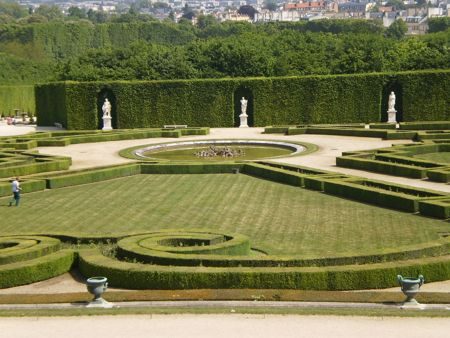
Check out the Ballroom Grove with its 8 level unique cascade and the Dauphin- Girandole twin groves with their symmetrical perfection. The Colonnade Grove with its circular peristyle and pilasters and columns in the northern grove clusters and the spectacular water theatre groves in the south row (fantastic fountain music and light shows are held here) shouldn’t be missed.
The parks are a natural extension of the formally designed gardens that stretch out extensively in a more natural form. There are two water bodies here; one of them is the famous Grand Canal… a 1.6km long canal that traverses the parks. The 1 km long petit canal crosses it diagonally and they are both designed to reflect the setting sun.
The 17th century Neptune fountain has 99 spouts and a stone dragon sits atop a pond to the north of the garden. The equally dazzling Apollon fountain has a grand chariot that’s pulled by ferocious horses….this is on the east end of the fountain. The Orangerie with its bevy of tropical plants is another important part of the garden.
You can access the garden through several different gates like the main gate, Chapelle gate, Dragon gate, Neptune gate, Menagerie gate and Little Venice gate.
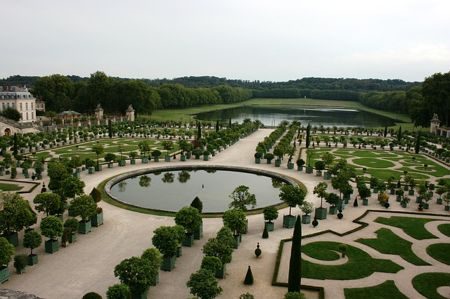
The Parks can be accessed through the main gate, queen’s gate (accessible by vehicle), sailor’s gate and the saint Anthony’s gate (accessible by vehicle).
If you are visiting between April to October don’t miss the musical fountain shows that happen on Tuesday, Saturday and Sundays. Different circuits are laid out for visitors who stroll around and look at the fountains dancing to classical music compositions. Every Saturday from mid-June to September there is the fountains night show when dozens of light, sound and stage effect professionals collaborate and create stunning installations that create a magical atmosphere in the garden. Lasers light up the sky around the colonnade grove and firework shows happen by the Grand Canal…the show usually happens between 8.30 p.m. to 11.00 p.m.
There is a feature called musical gardens on Tuesdays and Fridays (March to October) when certain groves that are closed to the public on other times of the year are opened with refurbished decorations and lovely music.
The hall of mirrors hosts a French ball with dancers and musicians from Compagnie Baroque right after/ before musical fountain shows on Saturdays between mid-June to September.
Concert and operas and religious music recitals keep happening inside the Versailles Palace in locations like Royal Opera, Orangeries, and Hercules Salon etc. These have all special entry fees and you need to keep checking the official website for events updates. The timings and dates of the above mentioned shows and events are subject to change and needs to be verified from the Versailles Palace Official Website.
Trianon Complex
The Grand Trianon and Petit Trianon were built as an escape from courtly life and so they are positioned quite far from the main palace. It will take you approximately half an hour to reach the Trianon complex from the palace by foot…you will need to cross the main Versailles garden first.
The pink marble Grand Trianon palace was made for the royal mistress of Louis XIV Madame de Monte span. This is one of the most elegant structures of the palace complex and is known for its elevated terraces and colonnaded arcades. The structure is single storeyed with courtyard and gardens on both sides. The roof has a balustrade that’s filled with sculpture and decorative vases. The décor of the rooms of the two wings here are more modern and different from the usual French formal style of the Versailles palace.
The Trianon palaces are flanked by English gardens filled with orange blossoms and shrubbery. Check out the Madam L’Imperatrice, Grand apartment (contains the well-known Cotelle gallery) and the Persityle sections here and you will understand the difference in style from the courtly apartments of Versailles Palace.
The petit Trianon was built much later for Louis XV at the urging of Madame Pompadour but it was Marie Antoinette who used this place extensively when it was presented to her by her husband Louis XVI. This is a Greek/ cubist style structure very different from the elaborately designed palace. The garden here allows nature to run in glorious abandonment with sparkling streams and wildflowers by bridges instead of the French formal style.
Also check out Domaine le Marie Antoinette …a charming mini country hamlet that was built to let the queen escape the courtroom stress Located in the private botanical gardens of Louis XV near the Trianon complex… this has peasant houses, dairy, dovecot and even a mill. Surprisingly the royal lady who often dressed as a farmer’s girl and retired here was completely out of touch with common people’s plight.
The hamlet’s peasant houses have simple exteriors but rich interiors and parties often happened inside. A lot of animals like pigs and cows exist in the farm now…they are all looked after by the foundation for animal welfare. The Temple de l’Amour and the Belvedere pavilion along with the lovely pavilion Francais (designed by Jacques Ange Gabriel) lie further inside the Trianon gardens…walk up to these structures from the hamlet for a nice experience.
Royal Stables
The Royal stables are situated right opposite the palace at the edge of Place d’Armes (3 avenues commence from here). Back in medieval times they were known for housing some of the finest breeds of horses.
One of the largest stable complexes in the world…the twin stables were commissioned by Louis XIV and built by Jules Mansart. Each stable has a main courtyard with an attached semicircle and an indoor arena. Horse shows, mock battles and other events were a regular part of the stables which housed an endless array of carriages and other royal vehicles. Right now Gallery of Coaches in the great stables and Sculpture Gallery in small stables are open for visitors. National School of Architecture, Centre for Museum Research and Restoration and Equestrian Academy are now housed in the Royal stables. The Gallery of Coaches is noted for its travelling thrones gallery/ grand ceremonial Berlin Coach assembled …each dazzling carriage has its own story to tell like the Napoleon Marriage coach, Bordeaux duke baptism coach, Charles X coronation coach etc. The coaches were made by the best architects, sculptors, gilders, upholsters of France.
Open Hours, Tours & Tickets
Versailles Palace is open every day apart from Mondays, January 1st and December 25th.
The palace and its apartments, chambers and galleries are open from 9.00 a.m. to 5.30 p.m.
The parks and gardens are open every day from 8.00 a.m. to 6.00p.m
The ticket office is in the main courtyard in the South Minister’s wing. You can buy the tickets there and then go to Entrance A. for visiting the Trianon estate exclusively go to the Grand / Petit Trianon entrances where there are separate ticket offices.
Tickets come in different categories like the Passport (allows access to the whole estate), palace ticket (palace, gardens and coach gallery) and estate of Trianon ticket (coach gallery, garden and Trianon estate) etc. There are 2 day tickets, temporary exhibition tickets and timed tickets (allows access within half an hour of given time) and many other variations.
Prices vary from 12 euros per person for estate of Trianon tickets to 27 euros for passport tickets with access to musical fountain shows etc. Buy timed entry tickets or online tickets to cut queues…these are available on the official website.
Admission to the Gallery of coaches, park and gardens (except on musical fountains show days) are free of charge. On fountain shows and musical garden days there is a cover charge around 7 euros.
Tickets are free everywhere every first Sunday from November to March, so expect massive crowds.
If you need to take a guided tour then go to the welcome desk in North Ministers Wing …it’s to the right of the main courtyard. Usually tours are priced at 10 euros over and above the ticket price.
You can also book various Versailles Palace tours online through this Viator site.
A number of passes cover a visit to the Versailles Palace including the Mobilis, Navigo and Paris Visite Pass. The passes generally have free access to the palace and gardens, Trianon, Queen’s hamlet etc. but not the fountains show.
Location & How To Reach
The Versailles Palace complex is in Versailles that’s about 20 km away from Paris centre. Most tourists who visit Paris also visit Versailles and there are a number of conveyance options.
Train
You can take the RER Line C to arrive at Chateau Rive Gauche station and then take a 10 to 15 minute walk to the palace.
You can hop on the SNCF trains from Gare Montparnasse to arrive at Versailles Chantiers station that’s about a 20 minute walk from the palace. Alternatively SNCF trains from the Gare Saint Lazare station come into the Rive Droite train station which is about 18 minutes away from the palace.
Shuttle and Bus
There is a dedicated shuttle called the Versailles express which runs from Eiffel tower to the palace 3 times a day (7.45 a.m., 9.45 a.m. and 1.30 a.m.) and comes back. Catch it from port Bourdonnais at the Eiffel tower base…you can book tickets online.
You can take the RATP bus line 171 that runs between Pont Sevres (metro line 9 terminus) and Versailles in 30 minutes. The TRI bus of Versailles Phebus runs between all the Versailles train stations and Trianon palaces
There are Many car parks in front of the palace and park …parking is payable but is free for disabled visitors.
Getting around in the Palace grounds
One of the best ways to explore the park, gardens and grounds is to hire a bike from the Little Venice hire point on Grand Canal banks and the Porte Saint Antoine. A little hop on hop off train also runs through the palace grounds and rowing boats run along the Grand Canal providing different options of enjoying the palace. Segway tours are available from the Grand Canal side outlets.
Address:
Place de Armes, Versailles
Phone: +33 1 30 83 78 00; Official Website
There are plenty of restaurants around in Versailles Palace and Park. There is La Petite Venise in the middle of the park…it serves Italian food. You can gorge on artisanal ice cream, waffles etc. from Gourmandises de la petite Venice that’s sandwiched between Apollo fountain and Grand Canal. La Buvette Du Dauphin is another takeaway stand near the Dauphin’s grove.
Girandole grove has Brasserie de la Girandole that serves pizza, salads and crepes. Then there is the Angelina terrace and food stand at Petit Trianon that serves primarily snacks. But the star of the show is La Flottille that serves classic French food on the Grand Canal…there is even a kids special menu. And of course if you have time, pack your own picnic hamper and enjoy it in the park grounds.
Don’t forget a visit to the Librairie des princes for picking up history books and maps and the Kings Medal Cabinet for buying an authentic Versailles souvenir. Books, saplings and gifts from the Garden’s shops and delicatessen offerings from Angelina shops are other temptations.
While you are in Versailles don’t miss a visit to the Versailles Cathedral. Considered an important French national monument, this had its stone laid by Louis XV in 18th century. Right now this serene Baroque monument hosts several old paintings and it the abode of the bishop of Versailles. The 1686 built Notre Dame de Versailles has lovely sculpture and neo classical architecture…it’s just a few steps away from the Versailles garden. And of course a jaunt around the colourful markets and street shops of Versailles Square is highly recommended.
3 to 4 hours for the palace, grounds, gardens and estates and the next couple of hours for the ancillary attractions in Versailles should make for an interesting sightseeing schedule.
 A travel addict. Still celebrating the day when he quit his high-profile corporate job to pursue his passion for travel writing.
A travel addict. Still celebrating the day when he quit his high-profile corporate job to pursue his passion for travel writing.